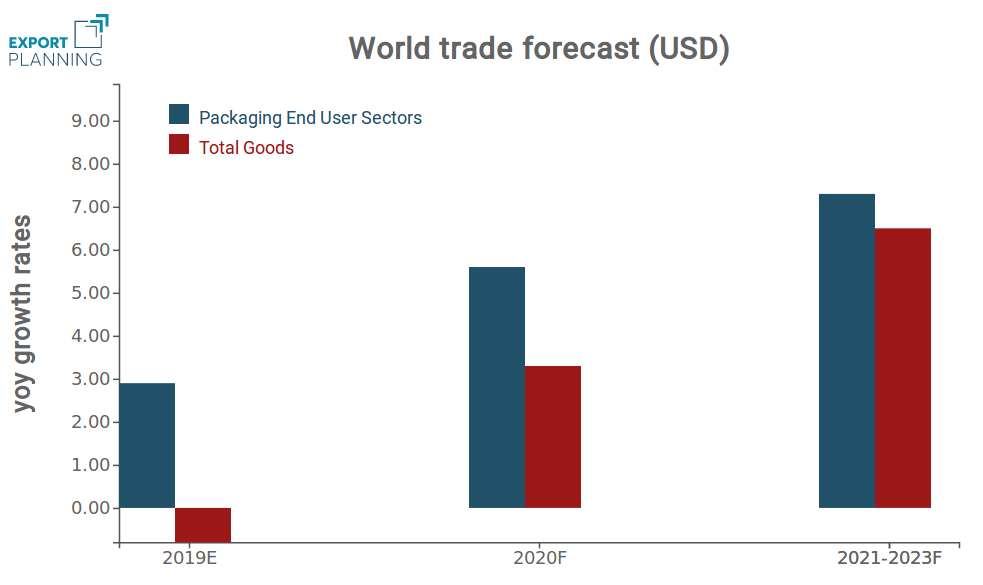Packaging Industry: the long-term Growth of end-user Sectors
Opportunities for companies in the Packaging supply chain from the Premium growth of main end-users sectors
Published by Marcello Antonioni. .
Health products Internationalisation Fashion Premium price Intermediate goods Food&Beverage International marketing Consumption pattern Industries Forecast Global demand International marketingIn 2019, the growth of world trade in packaged consumer products continued
The 2019 pre-estimates1, formulated by StudiaBo on the basis of the most recent economic data, indicate the continuation of the growth path of world trade in the main packaging end-user sectors.
In 2019, global demand for Packaged Food and Beverage2 showed estimated growth at constant prices of more than 5%, amounting to €512bn (or $573bn) according to our estimates.
Similarly, at year end, global demand for Perfumes and Cosmetics3, thanks to an increase at constant prices of about 4%, is estimated to exceed €86bn ($96bn); global demand for Personal- and Home-Care4 products has risen by almost 3% at constant prices, reaching €156bn ($174bn), according to our estimates.
Last but not least, global demand for Drugs & Medicaments5 is experiencing an increase that, by the end of 2019, should be close to 6% at constant prices, bringing the value of world trade to €546bn (about $612bn).
Particularly favorable medium-period
dynamics in terms of quantities
The growth performance of global demand in the main end-user packaging sectors appears to be above average not only in the most recent period, but also in the whole historical experience of the current century. In the average of the period 2001-2019, the Compound Annual Growth Rate (CAGR) measured at constant prices - thus excluding any inflationary or currency effects - is +3.8% in the Personal and Home Care sector, +4.4% in the Packaged Food and Beverage sector, +6.4% in the Perfumes and Cosmetics sector, and +8.2% in the Drugs & Medicaments sector, compared to a growth benchmark of +3.3% for total world trade in goods.

Source: ExportPlanning
These growth rates confirm not only the "acyclical" nature of demand in these sectors in a context of a significant slowdown in the international cycle - as written in a previous article -, but also the presence of peculiar driving factors such as:
- The growing importance of Premium segments, as documented by the growth in quality purchases in all these sectors
- Some "fashion" effects (for example, the growth in Asia of the skin care phenomenon)
- Demographic factors (linked to the average ageing of the population) in many high-income countries
Growing importance
of Premium segments
The growth performance at constant prices, which is more dynamic than the average, is also associated with an upgrading of demand in the main consumer packaged goods sectors.
Considering the incidence of the High and Mid-High price bands on total world trade by sector, the average for the period 2001-2019 shows particularly significant increases for Perfumes and Cosmetics (with the relevance of the "Premium" segments rising from 5.4% in 2000 to almost 54% in 2019) and Drugs & Medicaments (with the Premium segments this year representing more than 70% of the value traded worldwide).
The phenomenon is less accentuated in the Packaged Food and Beverage sector, where 28.4% of the value traded worldwide is attributable to the Premium segments; this is, however, a higher incidence than the one shown by the total goods (25.9%). Moreover, from the beginning of the Great Recession to the present, in the Packaged Food and Beverage sector, the upgrading process has intensified, with only the High Price Range doubling its relative importance (from 6 to 12%) and the Medium-High Price Range consolidating its share (above 16%).

Source: ExportPlanning
Growth opportunities in the 2020-2023 scenario
The forecasts recently formulated by StudiaBo6, starting from the latest World Economic Outlook of the International Monetary Fund, show for the 2020-2023 period particularly accelerated trends for world trade in packaged consumer products.
In the 2020-2023 scenario, it is expected that more accelerated dynamics will generally continue for the sectors that use packaging the most: in particular, a CAGR of +8.2 in $ (+7.6% in €) is forecasted for the Drugs & Medicaments sector, a CAGR of +6.5 in $ (+5.9% in €) for the Perfumes and Cosmetics sector, +5.9% in $ (+5.3% in €) for Packaged Food and Beverage, in the face of a +5.7% growth forecast in $ (+5.1% in €) for total goods.
In particular, next year - against a weakly positive trend for international trade in goods (+3.3% in $, +3.2% in €), growth rates are expected to be more than double the average in the Pharmaceuticals sector (+7.1% in $), and more dynamic than the average - albeit to a lesser extent - in the Perfumes and Cosmetics (+5.2% in $), Packaged Food and Beverage (+4.5% in $) and Personal and Home Care (+4.4% in $).

Source: ExportPlanning
Conclusions
These projections confirm a scenario of opportunities for companies in the Packaging supply chain, even though in a context of greater uncertainty linked to possible changes in both consumer habits and regulatory frameworks in favour of more environmental friendly packaging solutions.
In particular, forecasts for technology suppliers appear relatively less favourable, as they are more penalised by the effects of the current climate of uncertainty experienced at the international level, which is particularly affecting the instrumental mechanics sectors (see the recent article "Effects of the Great Uncertainty at an International Level: Machinery is the most Affected Industry in terms of World Trade").
1) For more information, please refer to the Ulisse Datamart in the Analytics section of ExportPlanning.
2) See the products' list analyzed in the following industry's description.
3) See the products' list in the following industry's description.
4) See the products' list in the following industry's description.
5) See the products' list in the following industry's description.
6) For more information, please refer to the Forecast Datamart in the Analytics section of ExportPlanning.


